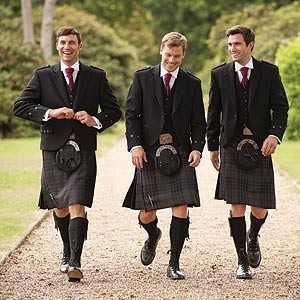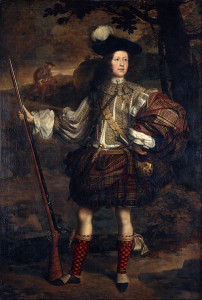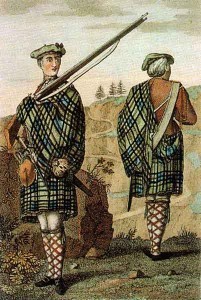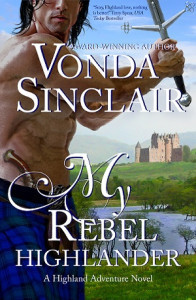Vonda Sinclair tells us what’s under that kilt
I’m naughty. Actually, historical fiction writer Vonda Sinclair tells all about the history of the kilt or plaid or feilidh-mor. I loved this post, as I hope you do too. Here is some music for you while you read and savor Vonda’s piece!
History of Kilts
By Vonda Sinclair
If you attend Highland Games or if you read Scottish romance novels, you’ve seen a lot of kilts, the national dress of Scotland (for men). A lot of confusion exists about kilts, what they are and when they were worn. One of the best books on the subject is Old Irish and Highland Dress by H.F. McClintock. He looks back to primary sources describing the dress of Ireland and the Scottish Highlands from Medieval times.
Some of this confusion about kilts stems from carvings from medieval times which depict the leine, the tunic and light quilted armor called cotuns in Irish Gaelic. In the 16th century in Ireland, men wore heavily pleated garments, called leinte. They were shirts that wrapped around and had wide hanging sleeves. They also had pleated skirts. But the earliest a kilt is shown to be worn Ireland is the mid 19th century. Medieval Scots didn’t wear kilts either, although a lot of people believe they did. This misconception existed even before the movie Braveheart.
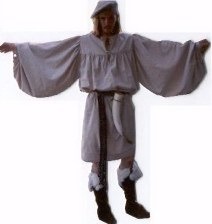
Leine
McClintock quotes a document called the Magnus Berfaet Saga. In 1093, the king travels to the Western Isles and dresses as they do there. The translation states, “They went about barelegged, having short tuics and also upper garments…” This fits in with what the Irish were wearing at the time, a leine and brat. There is no mention of a kilt nor belted plaid.
According to historical evidence, kilts were first worn in the Scottish Highlands in the late 16th century. This firstand early type of kilt is called a great kilt, great wrap (feilidh-mor), breacan-feile (tartan wrap) or belted plaid. And this is what most of the male characters in my (17th century) stories wear. It is simply a length of thick woolen fabric, usually of plaid or tartan weave. It was gathered in folds and belted around the body.
The first mention of what might be a belted plaid comes from 1578 when Bishop Leslie of Rome wrote, “Their clothing was made for use (being chiefly suited for war) and not for ornament. All, both nobles and common people, wore mantles of one sort (except that the nobles preferred those of several colors.) These were long and flowing, but capable of being neatly gathered up at pleasure into folds.” It sounds like a description or a belted plaid, although it truly doesn’t mention a belt.
Another historical document, this one from George Buchanan’s History of Scotland published in 1581 describes Highland dress: “Their ancestors wore plaids of many colors, and numbers still retain this custom but the majority now in their dress prefer a dark brown, imitating nearly the leaves of the heather, that when lying upon the heath in the day, they may not be discovered by the appearance of their clothes; in these wrapped rather than covered, they brave the severest storms in the open air, and sometimes lay themselves down to sleep even in the midst of snow.”
This shows how tough and hardy Highlanders were and explains how they used their plaids for protection from the weather and for camouflage. Again it doesn’t mention a belt, but it says it was wrapped. An unbelted plaid is considered to be a mantle or brat.
The first historical document which mentions the belted plaid is The Life of Red Hugh O’Donnell written by Lughaidh O’Clery. It is an Irish document written in Gaelic. It describes a group of mercenaries from the Hebrides of Scotland in 1594. “These were recognized among the Irish by the difference of their arms and clothing, their habits and language, for their exterior dress was mottled cloaks to the calf of the leg with ties and fastenings. Their girdles were over the loins outside the cloaks.” The girdle here probably means a belt and it is worn around the outside of the cloak. Mottled cloaks refer to plaid or tartan.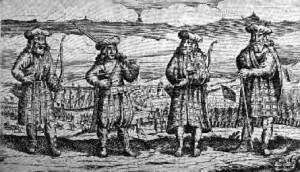
A belted plaid was about four or five yards long. Often lengths of material of 9 or 12 yards was purchased (and varying other lengths) and this narrow 25″ wide material was sown together to make it long enough to reach from above the head to the knees.
There are a lot of opinions on how to put on a belted plaid, but we actually don’t know how Highlanders put on their great kilts. They didn’t leave instructions.  All we have to go on are a few scarce descriptions of what they wore. Men probably used various methods to put them on, and they likely wore them at different lengths as this historical print from a woodcut of Scottish soldiers in 1641 shows.
All we have to go on are a few scarce descriptions of what they wore. Men probably used various methods to put them on, and they likely wore them at different lengths as this historical print from a woodcut of Scottish soldiers in 1641 shows.
The top of a great kilt (belted plaid) can be worn in many different ways, such as resembling a sash across one shoulder pinned with some sort of brooch. This is the most common way we see it worn. If it was cold out, this wool material could be unfastened from the brooch and pulled over the shoulders and head. It can also be left to hang loose and the ends tucked up into the belt at the back.
There is evidence that in the late 1600s and early 1700s the feilidh-beag (little wrap) started being worn. This is simply the bottom half of the belted plaid, with no top half sewn on. Although there is a rumor an Englishman known as Rawlinson invented this way of wearing the kilt, there is no evidence to support this. It’s likely the little wrap was worn before he had his Highland iron-smelting workers wear them.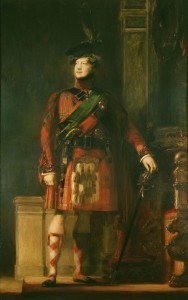
In 1792 the tailored kilt was created in which the box pleats were sewn into place. This is the first garment that can legitimately be called a kilt like is most often worn in modern times.
About the material kilts are made of, before the eighteenth century, there were no designated clan tartans. Basically, people wore whichever color, design, and weave they wanted or whatever they could get. This often depended on the natural dyes available in their area.
Thank you so much, Vonda, for all the information! For my current work in progress, I had to figure out how to undress a Highlander, and although, as Vonda points out, that there’s no instructions, thanks to YouTube I found out at least how to dress one.
Please check out Vonda’s latest book
Lastly, I won’t be posting next week. Please do me the favor of holding your loved ones extra close for me! See you in a couple weeks!

